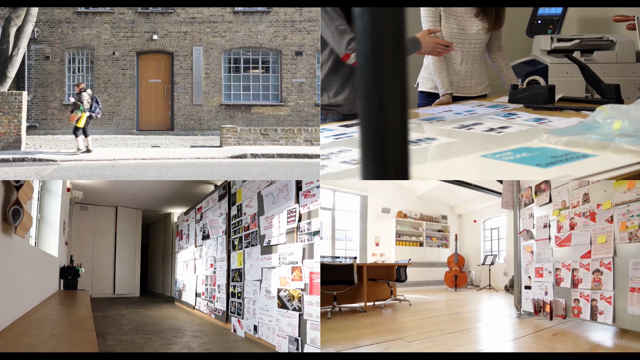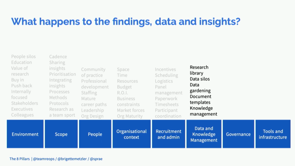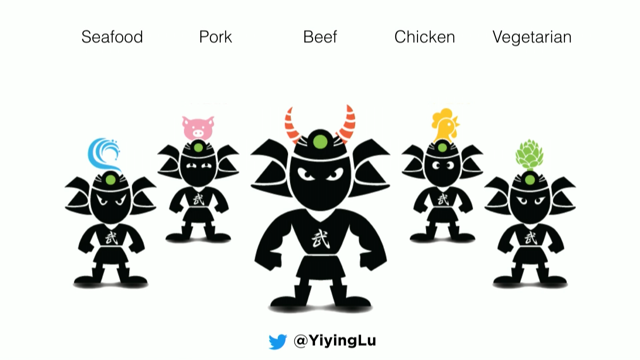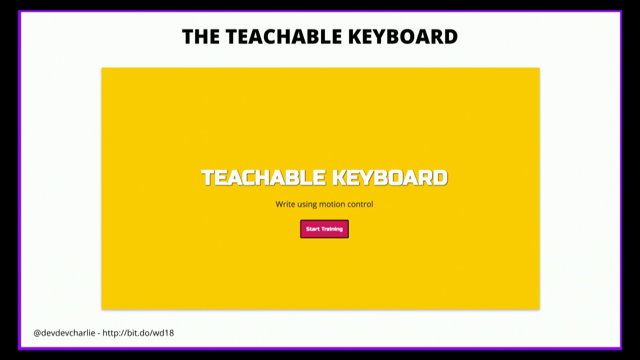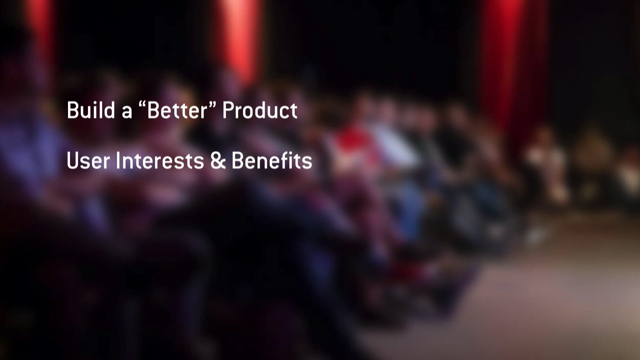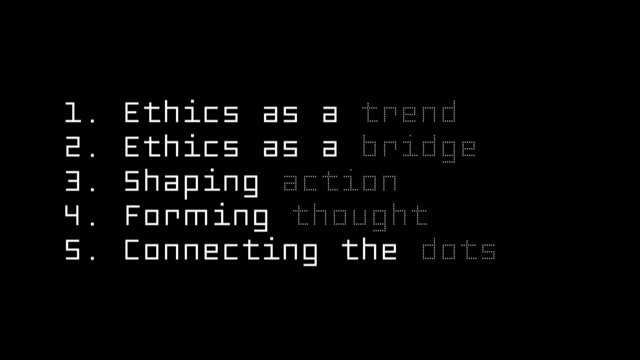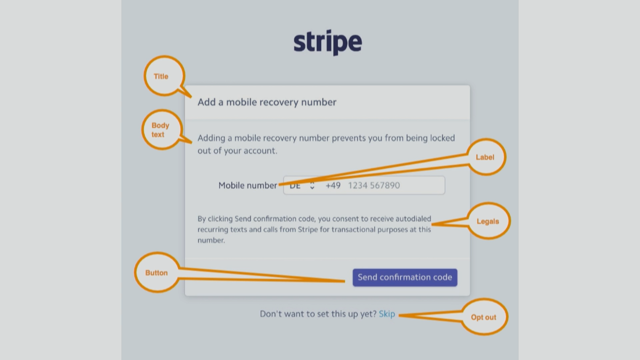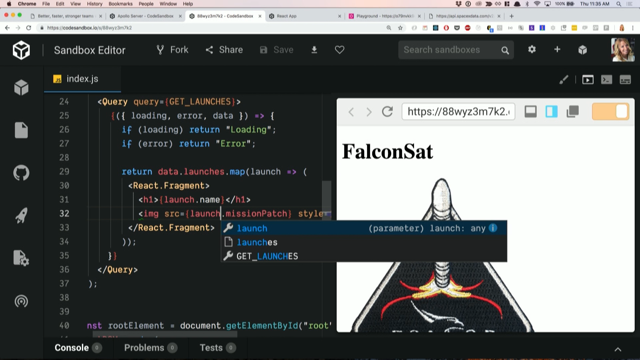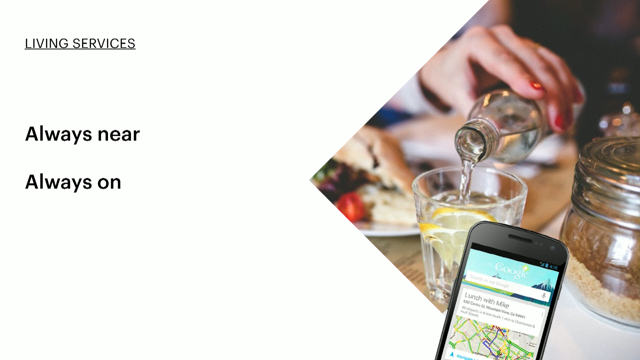
(syncopated organ music) - Thank you, first of all thank you Ling Ling for an amazing, brilliant, very inspiring (chuckles) talk. I don't think it's actually fair to have to follow you. Because you talk about Tasty Dumplings, sushi, Disneyland, and all I have for you is transparency.
So maybe think about an emoji for transparency, that would be interesting.
And because you brought so much laughter to the room, just to keep the fun going, bring on the German, right? (audience laughs) That always helps.
I want to start with a story.
About two years ago, I was honestly, completely overstretched in the projects that I was doing. I was involved in about three and a half projects, I was doing new business.
I was running around a little bit frantically through our studio, you might have done the same at some point in your career.
I was holding my laptop in the left hand, I was trying to have a phone call, sort of with my phone on the right hand.
And I was constantly checking other rooms where I could dive in to do a bit of deep work. To just concentrate and decompress and actually get that thought out of my head. So I was checking a few rooms, one after the other and they were all taken, of course.
And then I opened one door and the worst thing happened in this room sat, one of my teams that I was working with and my client.
And (chuckles) they looked at me and I was so ill prepared, I had no idea that they were coming in that day, so I was ill prepared.
And the way I looked at them, the only thing my client could say to me was, "Busted." And, that moment was one of those moments where I felt like, I could have done with a bit of transparency. This was really a big, missed opportunity to use transparency for the good.
So today I want to talk to you about that.
And, I think it's permeating the conference, actually. Yesterday I had the opportunity to listen to Joe who's sitting over there.
And now we've hard Mark in the morning about being more human.
I think this is general vibe that's in the community, and I see it more and more happening, that people talk about moral and ethics, and transparency as part of our design arsenal. Our tools, our methods, our techniques.
But at the same time, while everyone kind of thinks this is a hot topic and we should agree to use it more often, it sometimes feels like a bitter pill. It's medicine you have to swallow.
It's something that you feel like, eh, okay, yeah we should be doing more of this.
But there's so many things getting in the way of being more transparent.
And I was thinking about this and wondering why that is? Because, I bet you that everyone here in this room and outside in the other stream, none have an evil agenda.
Nobody's getting their employee handbook on boarding, you know, try to keep everything a secret, don't talk to your customers about how we make money. That's not how it really works.
I want to talk to you about how the way we are structured, the way we are communicating, the way we measure success and the way we reward people, is often in the way of applying more transparency. And I promise you towards the end of the talk I will give you a few examples of what you can do to bring more transparency into your organisations. So it's also a bit more practical, rather than me having a big talk about what we should be doing, I hope you get something out of this, that you can take away.
And on Monday morning, you have an idea of where you could apply it more often.
My talk is structured in three ways.
So first I want to talk about trust and value, how transparency leads to trust and value.
I want to talk about how transparency can be a complete game changer, reorienting the playing field, moving the goalpost, forcing others to play the game in a different way.
And lastly, how it is, and this is what concerns us really as a community, how it is an inside out process. How you have to start with yourself, you have to be transparent to yourself, to your colleagues, to your partners, clients, agencies, whoever they are, before you can meaningfully and sustainable implement it in the products and services that you're designing.
So, understanding the need.
The first chapter is really about hopefully bringing you onboard with understanding the need. And the second one will be more about how you can then sort of articulate it internally for the value that you bring to it.
And lastly, inspiration for how to change it. Let's go to one of the simplest definitions of transparency. So I looked it up and I found one definition, which is more the human definition.
Which is the characteristic of being easy to see through, like a window pane, or the ice that you saw in the first slide.
And the human transparency really is something that we encounter every time we meet somebody new. And that means, I try to understand and guess from your behaviour, facial expression, what you say, how you act, I try to understand your humanity, your needs. And this is really the important one, your intent. I need to understand what you're about to do. The way I am here up on stage, the way I'm talking to you gives us a few clues as to my intent.
I'm not gonna jump down here and hug anyone, or maybe I will at the end of the talk. (laughs) I'm not gonna break into song, that's very unlikely. My voice is terrible for that.
And, so that gives you an idea of what is about to happen. What I'm about to do, and that makes you feel safe. That's all it is, really.
It lets you lean back and think that, okay, I can see where he's coming from, I can anticipate what's gonna happen next, and I'm okay with this.
And it comes at a cost.
Just like an apology comes at a cost to my reputation, transparency comes at at cost of my future behaviour. Once I start being transparent, there's no possibility of then becoming really opaque and difficult to read, right? Because that breaks the chain of how you perceive me. And, so ideally you respond with a bit of transparency by being honest with the questions that you sent to Josh, hopefully with a hashtag does.
(laughs) And step by step we can increase our trust. So you respond with a bit of transparency.
And so it's not like I'm going 100% in the beginning and then you responded.
It's really a step by step process.
Just imagine I would do the opposite, you would have a really hard time to read what I'm about to do.
And it would bring in negative bias.
And this is one of the key human traits is that, if we don't know what's going on, we assume the negative, just to be on the safe side. So there's a negative bias towards, something that we don't know where we have to infer. There's also another bias against size, for example. So the minute the organisation that you're dealing with is very large, you tend to have an even more negative bias.
So it kind of accumulates in that way.
Again I want to say, transparency's not the only component of building trust, right.
So you have to be, for example, competent.
You have to feel like the other person, or the other organisation knows what they're doing, they're skilled in this.
And also you have to be reliable, you have to keep showing up, all of these things build trust.
But, transparency is a very, very important factor in the beginning of establishing a new relationship, or taking it to a new level.
Now if you look at business transparency, this definition here step by step, adds a bit of dimension for the commercial nature of transparency and trust.
It's the lack of hidden agendas and conditions. Accompanied by availability of full information required, for collaboration, cooperation, and collective decision making.
So a bit of a longer definition here obviously, but it helps you understand that this is a positive sum game.
This is not about one side gaining the upper hand over the other, you know.
Complete information availability for all, lack of hidden agendas, collective decision making is the key.
Now, why does that matter? Why does that matter for the future of the products and services that we're about to design.
We at Fjord we like to talk about living services. And we added the word living, because we defined them by three characteristics.
That they're always near, so think about your smart watches, I know you Yling you, mentioned to turn off your watch so it doesn't go off on stage.
So, some of these things are incredibly near and draw attention in.
They are, always on, like a smart speaker continuously listening, just waiting for you to behave in a certain way, to make a gesture, to say something to describe your intent.
And they're always learning.
They don't stop learning.
They build a genome of you, they understand your personality, your likes, your dislikes.
And most importantly it predicts intent.
And that's where we say living services become living when they start to understand you so well, that they can predict what you're about to feel, do, want, in the future.
And this supports another trend that we articulated last year called Taking Things Off the Thinking List. So a nice alliteration here with the three Ts. What does that mean? It's really in an era of all you can choose, simplicity wins.
You want to narrow down your choices.
Yes, you can have 47 versions of coffee, but if you know how I like my coffee on Monday, as opposed to Sunday when I have a bit more time, for example, that really helps me reduce the amount of things I have to think about. So it takes those things off the thinking list and I can move on to the more important things. So I could be like, Mark was saying, I could be more human with the people around me, for example.
'Cause there's not a gazillion things going through my head that I need to organise.
We also know that reducing the cognitive load is helpful, but then also taking action is helpful.
So to automate this, for example.
And we do this because we anticipate to be able to save time, save money, or just save cognitive load. Just the noise in our heads.
Naturally, all of these things run on data. And this is where it gets tricky.
These services can only become living if we consciously, deliberately, voluntarily share the data that we want to share, if we have full control over this.
Four years ago, we presented something at the Adobe Symposium, an installation that we call Creepy or Cool. It was a basic face recognition application that allowed people to judge on certain statements that we put in front of them.
So we talked about hyper-personalization, customization, and we let you be the judge.
Is this okay with you? Would you say, "Oh wow, that's cool!" And you would smile.
Or you would say, "Nah, that's a bit creepy, "that's a bit too much." And you would frown.
So basically voting with your face.
And while that was really, really fun for everyone to engage, the interesting thing that came out of it was that, about 2/3 or 3/4, 75% of the people were willing to share data if it meant more customization, if it meant this taking things off the thinking list. If it helped them lead their lives in a more efficient, more emotional, more engaging way. And, I said earlier, this was four years ago, and I think many things have changed in this short amount of time.
So we have a couple of incidents here where elections got meddled with, we had data breaches happen, misuse, we had organisations being investigated by royal commissions here in Australia, about how they treat their customers.
And, it almost seems like truth is now a matter of demand, rather there is an objective truth.
It just seems to be that if enough people want to believe something there will be a source saying that there is a truth such as this.
And PR company Edelman in 2017 found that 22 out of 28 highly developed markets are in distrust.
Meaning the majority of the people here in this room even the informed segment, and I would consider you to be 100% the informed segment, distrust organisations, companies, brands more than they trust them.
And I think we would all say we need to fix this. Facebook felt compelled to run an ad campaign on the ad shells, very traditional, for example here in an airport in Melbourne.
To say that fake accounts were not their friends, neither fake news or data misuse.
And, not surprisingly some people were in disbelief of that.
(audience laughs) So a couple of ad busters here in London, (audience laughs) did this. And while we don't all go out there and start pasting over billboards, it's something that really resonates with many of us.
It's saying like, yeah but, you know I don't trust you enough anymore, really.
Something has been broken in here.
So I want to talk about how transparency can be a contributing element to either re-instilling trust or bringing people to a new level of a relationship with the products and services that we all want to design and produce.
As a framework, I want to use the customer life cycle. So, if you could just briefly recapitulate what the customer life cycle really says.
I'll help you along.
It's about awareness, comprehension, like hey, this company has a new thing.
You know there's a service that I might interested in. It's about consideration.
Well, this could be relevant to me.
It sounds like I could give this a go.
And trial, okay I'll try it once, see what happens. Maybe it's a good experience.
And purchase, and loyalty, so really purchase being, okay here's my data, here's my money, here's my time.
And then loyalty, there's no other service I need for this, right? I'm not even gonna look, I might be aware of other services, but I don't need any of these.
And lastly, the Holy Grail of advocacy.
This means, I'm actually actively going out of my way, I'm starting to put my reputation on the line with my friends, I'm saying like, "You have never heard of this, "but you got to try this, it's amazing.
And we all know some of these services that are now being launched go from awareness to advocacy in such a short amount of time, it's incredible. But some others actually struggle to transition. So you might have been part of a team launching a product that never made it beyond consideration.
People became aware of it, there was a good campaign or PR around it, people understood what it is, they might have considered it, but it never really led to app downloads, it never really led to sign ups, never really led to anyone actively trying it. Well the same could be true for trial to purchase, or purchase to loyalty.
People just give it go, and then something happens like a data breach, and people just drop off and say like, "Nah, I've heard their not really "clear about their intentions.
"I'm not gonna keep on using them." So there's, as you can see, every company, every organisation, every government, wants to bring you into a service and wants you to become at least a loyal user of that service. So there's great value in transparency, building bridges rather than having these trust cliffs where you just fall off, where you just disappear.
And there's other forms of value.
Yesterday, at the AI summit we were talking about this sort of moral and ethical value of doing the right thing.
I just want to also put the lens on the shear commercial value.
Because if we as designers, as creators, as product managers, as strategists, as developers, if we talk to CMO/CTO/CEOs, all these people are also thinking about the commercial nature.
You can not go into these discussions just on moral and ethics alone.
You need to point to why this is saving them money, or why this is making them money.
Or why is it helping growing the service.
So for example we have compliance, GDPR has been in existence for awhile now, it had a huge impact.
You know just ticking the box of being compliant is a huge factor in how we develop new services. Cost saving, so just a shear average cost of a data breach is huge.
And, consider the brand equity that gets lost. You know once you've been known for actually doing this and not being clear about your intentions.
Let's look at, you know, Elon Musk or let's look at other founders who are sometimes not quite clear about why they're doing what they're doing and how sometimes irreparable damage is being done to a brand. And lastly productivity.
So we know that for a fact, neuroscience tells us that high trust organisations and teams outperform way outperform low trust organisations.
And you can build that trust into the teams and therefore, create greater productivity, longer retention, you know higher engagement of each employee.
All these things can be factored in and can be turned into a money as much as a moral and ethics discussion.
So that's the first chapter of really talking about how transparency leads to trust, leads to value and that helps you sort of get on board and understand the basics of why that's valuable. And I want to talk about the second chapter which is the game changing nature of transparency. And I want to talk about product features, for example. How you can literally in physical product, see the transparency in them.
How transparency can become part of information or disinformation and PR efforts.
How it can become part of the business model. It can be the core of the business model to be transparent about something.
And lastly I want to mention blockchain as one of the prime examples of a technology that allows for shared understanding and trust, and believability in data. You all remember Google Glass being launched awhile ago, right? So it was a big fanfare.
Never before had people been so excited about a particular device being launched.
And it was very difficult for people to get their hands on it, right? There was a sign up list, it was distributed slowly, a few lucky ones actually got these glasses. And then something happened.
Google made a big, big mistake.
And do you know what that mistake was? (audience laughs) Yes, it was the models. The models they chose to don the glasses to bring them into the mainstream.
(audience laughs) And if you don't believe me, look at what Snap did.
See the difference? Make sense? Obviously it wasn't about the models, it wasn't about these people who don the glasses in the first place, although obviously that makes a big difference.
Especially when you're ripped and you're not wearing a shirt.
(audience laughs) I want to talk about another flaw that the Google Glass really had, and that was to form it, that was a shear, physical feature set that it had, that, you know there's other issues probably with the Snap spectacles, as well.
Like transferring the files and the bulkiness and whatnot. But really the big different is this.
This allows you to signal to anyone around you that you're recording.
And you might remember the Google Glass people got called glassholes for looking dorky in the first place, but also.
(audience laughs) Getting attacked in a bar, at least there was one story around it, somebody got punched because somebody else didn't quite know, are you just looking in my general direction, or are you recording this particular scene in the bar? And this goes back to the negative buy, as I mentioned. If I don't know what you're doing, I'm gonna assume the negative.
You might just be looking in my direction, but I'm gonna assume you're a geeky perv and you somehow get off on recording everyone in this bar. It will be interesting to see now you see the new generation of smart glasses.
They're getting less conspicuous, Intel View. All these people bring out devices and you see the gentleman on the bottom left here. Is he literally checking his running stats? Or is he just sort of nervous? Is he just adjusting his glasses? We don't know.
So these formats, this behaviour, this method of communicating what you're doing is not quite clear. So, it will be interesting to see if people again will have trouble focusing on the human interaction if they don't know what's going on with the interface. If there's no signal, if there's no overt amount of transparency over what I'm doing right now. You might have heard of Facebook launching the Portal, and whether or not you're a friend of having a specific sort of video device on it.
I found it very interesting how they made the deliberate attempt, and I believe without having been part of the product development team is, that it was an afterthought.
Because they also give you this clip.
Now if I was an industrial designer I would sort of freak out.
Like, why do you suddenly add this stupid little plastic-y thing that gets lost after two days in my kitchen in some drawer? Why do you add this at the last minute? Because, I believe and this is just an inference here, that the team realised, "Okay we've got to give "the people the chance to objectively "shut off the camera lens." It's not enough to say, "Hey here's a light, "or there's an audio signal," or something else. We need to make it impossible for people to feel like they're being observed without them wanting to.
Google learned the lesson.
So they had the Google Home come out and as you might know if you own one or have seen one, the only physical button it has is to turn off the microphone.
There's no other button.
And it does a little audio signal, it says that it's actually off and it also gives you a light.
So it's very, very clear about, by default I'm on. That's understood, you know every time you have it on in the house, it actually records, or it could potentially listen to anything being said. And you can turn it off.
Another little friendly helper in our home might be the Roomba by iRobot.
Sort of scurrying around, cleaning our floors, being a really helpful little device.
But it also has a camera.
Also it understands how big a room is, understands what's maybe lying on the floor, whether or not there's kids in the home.
So, naturally, without them doing anything there was a story developing that they were selling the data, they were selling the data to real estate agents, or what not.
It wasn't true, they denied it.
But theoretically this device can do that.
And, Nicholas Negroponte in the '90s said you know, anything that can be digital will be digital. And we know from IOT anything that can be connected will be connected.
Anything that can be measured and expressed in data will be measured and expressed in data.
So we can be sure of it, that it will be collected. It's our question, what are we gonna do with it, how we're gonna empower people to be transparent about the use, and give consent.
Amazon Key, now allows you to open your home, because you're weighing up, am I gonna leave my package outside, for anyone who I don't know might pick it up, might steal it, or might see what's inside of it? Or, I can connect it with my key and automatically the door opens.
Very importantly, I can connect it to a camera and I can see the delivery.
So I can see it in real time, or I can see it in a recorded way.
There was a little study around how ready are we to open our homes? I think Joe, yesterday you mentioned something around the US Postal law, that nobody's allowed to open your mail, under threat of 5 years in prison. Now suddenly we're at a stage, where we say like, "Oh yeah, somebody I've never met "because I trust Amazon, or because it's more convenient "that I'm opening my door for that person.
"And all I have is a recording "of that person delivering it." Moving away from the home, the third magic place is naturally transportation, it's the car.
So, we are moving into a space where the interior of a car is gonna be the most heavily monitored space in the world by square inches, or centimetres, however you want to call it.
So, the car will measure my gaze.
The Invidia car system understands where am I looking at this point? It also records my lips, so it understands what I'm saying without listening to me.
The question then is, as a designer, or as any strategist if you look at a very luxurious interior here of the Mercedes Benz, where would you put that button? Right? That one button that says, I'm not listening to you, I'm not watching you, I'm shutting off all my monitoring. There's so many elements in here that scream for attention and obviously as we move to become more passengers than drivers, it's not gonna be as full of little buttons. But still, the question is, where I can empower and be transparent about the use of my data and my monitoring in such a space? The next market that I want to talk about is not really a market that you have naturally sort of anticipated maybe two or three years ago. And that is disinformation, political information and disinformation.
We worked together with a company in the US called Graphica that have contributed majorly to the understanding of how the elections got meddled with by Twitter bots and active accounts, run by individuals. And what they bring is great transparency in hindsight. So, you see this cloud here of the US right, libertarian, US liberal, so they can understand the network connection in which several accounts might sit. And they actually relayed it in the same network. They also understand the temporal connection. So are they tweeting or distributing links at the same time? And then the semantics.
Are they pointing to the same sources? Are they using the same words? And all of this gives you an idea in hindsight of what happened.
Now, it's gonna be much more of a game changer, if you then can do it in real time.
And if you think this is only about politics, we're seeing about as many attacks on commercial institutions and brands and services, as we're seeing on politics.
So, imagine being part of a team that has worked really hard for two years, launches a product and it gets attacked with disinformation. Wouldn't you want to have that transparency on your side and at the same time you've got to be transparent about your own story.
So you got to have your story straight.
You got to have all the information ready.
Because the only way you can counter disinformation is by adding more information.
You can not shut down all these accounts in time, and you see this on the right hand side? What most people are thinking about is level one, which is these Twitter egg accounts.
The baby bots, the self-motivated trolls.
But we're already seeing a lot of crafted profiles. Bot farms, 50 cent armies, low paid people who are just paid to actually distribute this disinformation.
And lastly, we are coming into this age where AI helps these agencies to actually distribute that autonomously and really in a very sophisticated fashion.
And all of this is happening at the same time. So we got to be ready for this.
Another game changer in the financial sector is the international money transfer.
So some of you might know this brand already, TransferWise. Previously this market has existed in a certain way because of lack of transparency.
Banks would buy a certain currency and they would sell it for a different rate.
And that was how it was being done, right? We all understood that that's how banks work.
And they would say, "Oh no, no, no.
"10 dollars is all we're charging for this money transfer." I'm sending $100,000 somewhere and all I'm paying is $10.00 fee, is obviously not true.
The real profit, the real fee sits in the split difference between buy and sell.
So what TransferWise was doing was just cutting through and saying, "We're gonna charge you the average "daily market rate, which you can see anywhere online. "That daily rate is the rate you're getting. "And we're gonna show you exactly how much "we're gonna charge." Which could be in this case, yeah, $6.95.
And the game changing nature of that is that you can not go back.
Once you, you all know that this is possible, that this can be done, safely, securely in a timely fashion, very quickly, actually.
All the other players now have to play your game. 'Cause how can you ask for buy and sell rates when somebody has experienced this? So you can really flip the market that way. We're seeing it in fashion.
This is an Australian brand here, boutique brand called Arnsdorf.
And they're bringing transparency to their pricing. And they are making very clear that while they are a boutique brand with higher prices, their transparency lies in that they're splitting up how much their spending for designing on shore, labour on shore, distribution, back office, shop. And that again, puts everyone else under pressure. Because if we're transparent about how we're coming to our end price, then other people need to follow suit. We from Fjord have identified transparency, not only as one of our core values.
And in the introduction to the conference it says, you know, it should be more than just a footnote in your mission statement.
We have it as one of our values, but we've also identified blockchain as being one of the key drivers of this movement.
And we can bring more transparency with blockchain to it. So you can check out the full trend here now, on trends.fjordnet.com.
But I want to show you one example is where we're actively applying it.
We're changing the game for one of the most vulnerable people on Earth, which are refugees. In Thailand there's a refugee camp where we're applying blockchain for iris ID eye record. And that gives them safe, secure medical record access and to medical services, access to these services. And in the future, we're building currently, a version that allows them to record their educational attainments.
So if you've ever heard a refugee's story, often they have picked up educational skills in their home country and they're unable to prove it. Or it's not recognised in their new country. And they can not travel, because one billion humans on the planet do not have access to recognised travel documents.
So proving their ID, while that's not a commercial market, it's a real game changer for them.
So we talked about, in the second chapter, around how you can really move the goal posts and force everyone else to use transparency just like you do.
Now lastly, I want to get a bit more practical, so that you don't feel like, that was a nice spiel but I'm not gonna help the transfer of international money market any time soon, or I'm not gonna help refugees in Thailand any time soon.
I want to give you a couple of very specific examples, where you can apply it in your daily work.
So lastly I'm gonna talk about how Agile has brought a lot of transparency, obviously to our work.
But also the barriers, the internal, institutional, company, team barriers that we are facing. And how you can bring it into teams, into your career and your goals.
How you can bring it into each project and how you can bring it to a brand, or design guide in the end.
Let's talk about Agile.
So here you see a couple of my colleagues here in one of the totems of Agile-ness, which is that project space.
The space where the truth is on the wall, where all the research is, where all the ides, the intentions, the mishaps, the misfires, and also the successes. Not only does it show you what we're working on, it also shows you where we were coming from, it shows you where we went wrong.
But, it also shows you the methods we're using. So you'd be probably not surprised that we're using very, very similar methods like any other good design agency.
And that's not the differentiator.
We don't have a magic secret sauce that nobody else has.
I mean sometimes we adapt certain methods to fit certain purposes, but it's all in the way the team functions, the team has muscle memory, is able to deliver very quickly and communicate throughout. I want to mention Conway's Law.
This is something that Melvin Conway, 1967, the software engineer has postulated.
And it's about how the internal communications structure is one of the major barriers to true transparency and success.
And what he said was, that any organisation that is trying to design a system is constrained to mirror their own communications structure into that system.
So this is what he said, "Any organisation that designs "a system is constrained to produce a design "whose structure is a copy "of the organization's communication structure." If I'm designing a certain software part, and I have no idea who's designing part B, and I'm designing part A, these software parts will never work harmoniously together if our communication structure is broken.
If I don't understand the other part delivering this second part.
What that also means is that we all know we're delivering something in an MLP or MVP session, whatever you call that version.
We're delivering something in a very raw state. So we need to iterate, we need to pivot, we need to change the proposition.
We need to adapt, we need to change features and functions. We can not do that if we don't understand who's helping us deliver that.
If we're just sort of sending out requirement docs and getting them back, we're never gonna be able to pivot that quickly.
Or, in another way you could say just because the lion here is roaring in the front, it could be actually, that he's strapped (audience laughs) to a ledge in the pack and getting pricked by needles. Maybe that's, that's just an analogy, I'm sorry. I wasn't responsible for this lion being, I'm sure he's fine.
I think it was a medical examination.
What that means is, something that happens up front could be the result of a terrible communication structure, a rewards structure, the way we're organising our success structure in our company.
So here I want to be very transparent with you. Three years ago, we merged two teams.
We have about 35 in each team.
You see the different colour codings here, all these names. In any merger of two teams you have great nervousness, you have great uncertainty.
People over value what they had and they undervalue what they're gonna gain. And that's again, the negative bias.
If I don't know what's gonna come next, I'm not sure I want to be part of this.
So often, that's why you see when you merge companies or teams, that many people leave. Because they don't know what's coming.
And the way we wanted to address that and take a bit of that stress out of it was that we took the whole team and we just laid them all out in terms of like who's actually mentoring whom, who's maybe more senior and sort of helping others along the way.
The colours and the places were known so people could understand like, who's working Melbourne? Who's working in Auckland? Who's working in Sydney? What are their names? You know sometimes I don't even know what their names is. And I can sort of use that the then maybe ask a colleague like, "Have you ever worked "with this person, what are they like? "What do they prefer, what are they good at?" And all these things.
So just a small thing that took us about two hours to do, right? Free software Graph Commons.
Take your team and just show everyone what the structure really is, because often people don't know.
Another example is, you can put your priorities into a self reflection tool.
So we use this internally where we say, these are my priorities.
This was from a while ago, my own profile.
And I have certain priorities, certain goals that I want to achieve.
And I make them clear to myself first, and then to anyone else.
So the minute you are looking for support for a certain topic, you can say, "Well I'm gonna seek out the right person "to support me in this." And because there's only so many hours in the day I can't support everything, right? But I'm just really honest about it.
It's like, this is what's really important to me, this is what I need to do.
And if somebody feels the same way, they can help me achieve that and I can help them. Another tool we internally built, this was more an experiment was, we took the different strengths that people have and you might know the Gallop Strengths Finder. Give your strengths, and you show a typical team and what the distribution of different strengths are.
So you look at it and you say, okay this team seems to be really strong in relationship building, and nurturing, and supporting each other.
They might be greatly, heavily skewed towards being strategic, ideation, shooting for the stars. But they might not be that strong in actually executing craft skills delivering.
And once you know that this is kind of how your team is set up, you can be aware of that.
You can choose to actually swap people out and say like, "We need somebody who's really "much stronger in skills, and craft," for example and delivery.
Or you could say, "Well we know that this is the fact "and we need to address it as a team." So let's become aware of this, let's sit together and say like, oh we might down the line, we might have a problem.
We might have a great relationship with a client. But in the end we might not get there in time. So how can we address this along the way? And another example here is, my colleagues in Stockholm developed these templates that allow you to, for example on the left hand side you see the kick off team map.
In the beginning you just want to say like, who's actually on the team? Who's the core team? (chuckles) Like how often have you sat in a room it's like, are you actually, are you gonna stay on this? And how much time do you have for this? And then you have the support team.
So who is actually just you know helping off and on when required and who's in the client and stakeholder bucket? So that you know like random person coming into a project room wanting a stand up.
Wanting like, what is this? Are we doing Agile drama just for the sake of pleasing somebody who we've never met before? Or is this really an important stakeholder that we need to get across the line? The second one is the kick off team member. Tell me what are your skills? What really drives you? What do you want to get out of this project? What support do you need? Be open about this.
I don't know what I'm doing in this field, I need to learn.
Who can help me in this team to get there? And also like be honest, like what makes you grumpy? What situations just stress you out? So that I don't have to find that out four weeks down the line when it's almost delivery time and somebody's freaking out, and I have a no idea why.
So let's talk about it in the beginning.
Again another early version of a tool that we built, it's now almost ready to launch within Fjord is something that happens as you deliver a project. As you go through you want to understand how is the team doing? They don't always tell you.
Just because you're the project leader doesn't mean you know what's going on inside of them. And so, you get a weekly reminder to use this tool to just say, hey I'm doing well and this is why I'm doing well.
Or, I'm doing badly and this is why I'm doing badly. It's anonymous, so you don't need to fear that anyone can come back to you personally. But it allows you to say great clarity over the goals. Or too much workload.
Or, not enough support.
The equipment is rubbish.
You know whatever the reasons are and you get that, as a leader of the project, you get that and you get a true, full account of what you can do to address it.
And you can share that with the team and say, "Okay, let's address what's going wrong." Lastly, this is really kind of stock standard now. What we're doing, this work here for Westfield, we develop design systems, right? We make everything incredibly efficient, make it very clear for developers what's going on, they can collaborate, work on the code together. And that allows you to be as a brand, it allows you to be more efficient.
Here our work for Samsung, allows people internally maybe who weren't part of the product design team to actually understand what we build and how it's supposed to function, how it's supposed to sound and move and feel. And all these elements are fantastic for distributing transparency across the project.
You might even take it further.
Just like IBM here and distributed living language, something that anyone can see and understand what the brand is all about. What the values are and what is important to them. And, the reason why I'm saying this is a really a relief to me is, and any one designer really, is that you don't have to be the evil person slapping people over the wrist for using the brand in the wrong way.
Or using the design in the wrong way.
And so it moves you towards being an educator and a partner in executing the brand rather then being this. Which is design police.
I took this picture here at the Australian Graphic Design Association in Tasmania.
And what I find so funny about this is that if you're a bit of a tight nerd, you have to look at the kerning between the E and the S and you know what I mean.
(audience laughs) For somebody has to get the real design police to police these guys.
(audience laughs) If you're interested in further practises, how you can bring transparency in your daily design and development cycle, I highly recommend Nathan Kinch's work.
So you can go here to his work with his partners, Data Transparency Lab, Designing for Trust. He gives you real, very specific examples of how you can embed it in your research, in your proposition, in your early prototypes and how you test and refine.
And you bring trust and transparency into your daily work.
So, let's recap, the summary is really the value lies in that we're all human.
Like Marc was saying, be more human, right? If I walk into a room I make clear my intent, I'm transparent with you.
I'm gonna trigger, you know really positive signals from you as well and we're gonna raise our trust levels together.
And that ultimately leads to commercial value. This leads to growth, productivity, compliance. Secondly, it can be a game changer.
It can really, it doesn't always, but it could really reorient everyone who's playing in the same field, so suddenly I have to play your game, because you brought so much transparency into the game.
And lastly, hopefully you got some inspiration to take some of these examples and build your own version of it. You know, extrapolate.
But a team charter together.
But something up on the wall in your project room. Say like, this is what I'm all about, this is what's important to me.
This is what I hope to get out of it, for example. And not just wait until the retro, or the, you know the last session where you're actually kind of trying to do your dirty laundry, and you say like, "Ah we should have done "something differently earlier." So be up front about it.
And hopefully this then becomes a culture.
And it has to be supported by senior leadership, it has to come from them first.
So just like I was admitting to being busted by my client by not being on top of my schedule and running into the wrong room at the wrong time and looking like an idiot.
I need to ask for help when I don't know what's going on, I need support, as well.
And so, that has to become a culture, that then becomes part of how you deliver products and services.
So hopefully, you have many more inspiration, inspirational sessions coming.
But on Monday, when you get back to the office and you say I'll look at my notes, for something that I remember, hopefully you will ask yourself, so how can I be more transparent today? Thank you very much.
(audience applauds) (syncopated knocking percussion and organ music)

